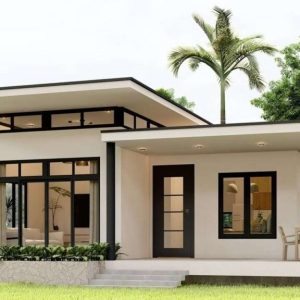Tiny homes have grown in popularity during the last decade, thanks to the steep rise in prices for conventionally sized homes and to a growing trend toward minimalism. But despite its initial reputation for being relatively inexpensive self-built projects, tiny houses, in general, have unmistakably gotten more and more pricey over the last several years, partly due to the emergence of “luxury” tiny homes, an oversaturated market, and a global pandemic that has pushed up prices for building materials.

Nevertheless, there are still some tiny house builders that are striving to offer relatively affordable tiny house models, like the Rumspringa line of tiny houses from Liberation Tiny Homes, a company based out of Leola, Pennsylvania. Named for the Amish rite of passage (literally meaning “to hop around”), one of the currently available Rumspringa tiny houses is the Carriage Haus, which starts at a moderate $69,900—though there is always the possibility of adding upgrades.

According to the company, the concept behind the Rumspringa series harkens back to simple living and the humble roots of the tiny house movement. Much of the materials for Liberation’s tiny houses are sourced locally, and its design aesthetic and construction know-how comes from many of the team members’ deep cultural roots in the local Amish community.

Measuring at a generous 283 square feet (26 square meters) including the upstairs lofts, the 24-foot-long Carriage Haus boasts an exterior clad with durable engineered wood siding and topped with a metal roof. Part of the loft juts out, but not too noticeably, lending a bit of extra floor space above.

Inside, there is a distinctly modern farmhouse feel. The interior seems light and airy, thanks to the generous use of warm-toned wooden surfaces, against a backdrop of bright white painted walls.

Directly opposite the main entry door is the kitchen, which has a long, sturdy wooden counter, with a large metal sink and pull-down faucet right in the middle.

One can store things in the cabinets and drawers underneath the counter, or in the open wood-and-metal pipe shelving above. Off to the side, there is a space reserved for the included apartment-sized refrigerator. Besides this main counter, there is another smaller set of cabinets, shelving, and a counter on the opposite wall, thus augmenting the amount of space available for food prep and storage.

Here is a view of the dining counter for two, which offers a view out through a big window. This table can also double as a sunny space to work from.

The space can be cooled with the help of a ceiling fan that hangs over the center of the home. Past the dining area, we have the living room, which can fit a small couch in either direction, as well as a small coffee table. This zone is lit naturally with the help of two small operable windows.

The stairs are wide and look easy enough to climb, and also integrate some storage cabinets within. The metal pipe handrail provides an extra safety feature that can be sometimes lacking in some tiny houses, but its position on the wall makes it less obtrusive.

Upstairs, we have a cozy sleeping loft just on top of the living room. This space is punctuated by two windows that can open on either side, plus some convenient wall-mounted lighting for reading in bed.

Back downstairs and on the other side of the tiny home, we find the bathroom behind a barn-style sliding door, which helps to save space while still keeping it private.

The bathroom has a lovely sink and built-in vanity, a shower, and a flush toilet that comes standard— though it can be upgraded to a composting toilet.

There is some open shelving cleverly tucked into a nook behind the shower. The layout and careful detailing here makes this bathroom feel much more substantial and elegant than a typical tiny house.

The company has come a long way from its first tiny house debut, and while the Carriage Haus is categorized under the more affordable series of Rumspringa tiny houses, Liberation nevertheless also has their more high-end Signature series of tiny houses as well, which offers more customization options, and starts at around $80,000. To see more, visit Liberation Tiny Homes.






